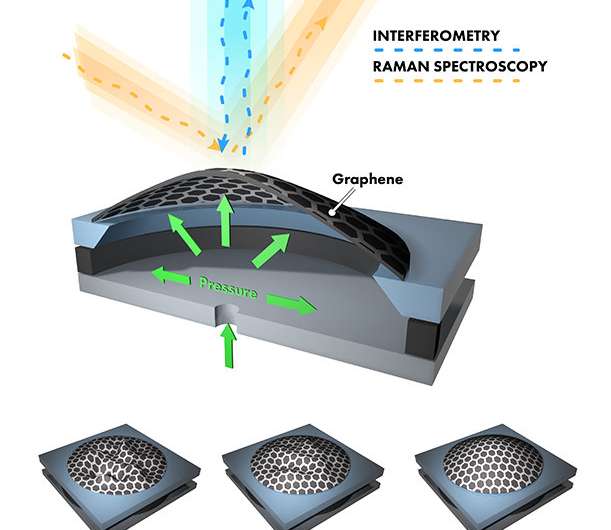Crumpling reduces rigidity in an otherwise stiff material, making it less prone to catastrophic failure

Gas pressure was applied to a crumpled graphene membrane to cause it to bulge and stiffen. The result? The gas pressure revealed that this atomically thin carbon material—universally assumed to be strong and stiff—has a "softer side." The greater than expected reduction of rigidity with increased crumpling caused researchers to refine their understanding of the material's mechanics.
The finding of soft mechanics in a hard material gives engineers a "knob" for tuning properties. That is, changing graphene's shape, or degree of crumpling, changes its stiffness. Materials can be strain-engineered for applications in which less stiffness is desirable, such as bicycle components, in which reduced rigidity works as natural suspension to dampen a harsh ride, or aircraft parts, in which less brittle materials are less prone to catastrophic failure.
Although graphene is considered a 2-D material, it never exists in a perfectly flat state. Like wrinkled skin, when this atomically thin carbon is synthesized, by any technique, it is crumpled. At the Center for Nanophase Materials Sciences, scientists subjected a graphene membrane to pressurized gas to make it bulge, stretching out its wrinkles and allowing measurement of elastic properties at different degrees of crumpling. The experiments were especially challenging due to the membrane's thinness. The scientists used Raman spectroscopy to measure changes in strain for the graphene (revealed by vibrational spectra, or signatures of interactions between atoms) and interferometric profilometry to measure surface topography of crumpled graphene (deflections of a few microns along the vertical axis, i.e., perpendicular to the plane of perfectly flat graphene).
These complementary techniques let researchers look at the same sample in different ways to gain a new understanding of what happens as graphene flexes. They discovered an unexpected nonlinear relationship between the force applied to a crumpled graphene membrane and the distance it deflects compared to what theory predicts for perfectly flat graphene. That means that initially the material yields easily but becomes progressively stiffer the more it is deformed (in this case, as the graphene membrane bulges in response to the pressure of the gas). "Softer," or less rigid, carbon materials could be advantageous in many engineering applications, such as structural materials that are less likely to develop cracks and may yield before they reach the point of failure. These "crumpled" materials could prove superior to strong but brittle materials that fail catastrophically.
More information: Ryan J. T. Nicholl et al. Hidden Area and Mechanical Nonlinearities in Freestanding Graphene, Physical Review Letters (2017). DOI: 10.1103/PhysRevLett.118.266101
Journal information: Physical Review Letters
Provided by US Department of Energy





















